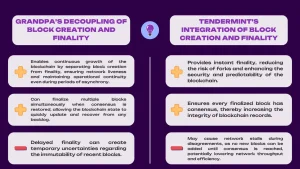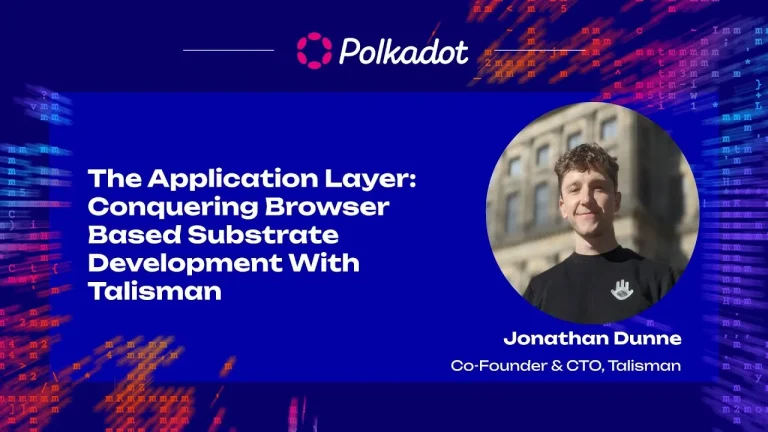Blockchain technology has evolved significantly over the past decade, with one of its core pillars being the consensus mechanism. The consensus mechanism is what ensures the integrity, security, and efficiency of a decentralized network by enabling participants to agree on the state of the blockchain. Two prominent consensus mechanisms that have drawn substantial attention are Polkadot’s GRANDPA (GHOST-based Recursive ANcestor Deriving Prefix Agreement) and Tendermint, primarily known for its implementation in the Cosmos ecosystem.
This article aims to provide a detailed, comparative analysis of GRANDPA and Tendermint, highlighting their operational principles, strengths, weaknesses, and the contexts in which they are most suitable. By doing so, we will dive deep into how these mechanisms handle critical functions like block creation, finality, and overall network performance.
The Role of Consensus Mechanisms in Blockchain
Before delving into the specific attributes of GRANDPA and Tendermint, it’s essential to understand the role of consensus mechanisms in blockchain technology. In decentralized networks, consensus mechanisms ensure that all participants agree on the validity of transactions and blocks without the need for a central authority. Different consensus algorithms employ distinct methods to achieve this agreement, balancing factors such as speed, security, scalability, and finality.
Finality, in particular, refers to the point at which a block (or set of blocks) is considered permanently part of the blockchain. Once a block reaches finality, it becomes extremely difficult, if not impossible, to alter, ensuring the immutability of the data within the network. Both GRANDPA and Tendermint address this issue, albeit through different approaches.
GRANDPA: Decoupling Block Creation from Finality
Polkadot’s GRANDPA is an innovative consensus mechanism designed to enhance network performance by decoupling block production from finality. In traditional consensus systems, block creation and finality are intertwined, often leading to delays and inefficiencies during periods of network instability. GRANDPA’s separation of these two functions allows it to resolve this issue.
Key Features of GRANDPA
- Separation of Block Creation and Finality: GRANDPA enables continuous blockchain growth by separating the process of block creation from finality. Validators can propose blocks without waiting for them to achieve finality, which means that the network can continue to process transactions even during periods of asynchrony. This feature ensures that the blockchain remains operational even if there’s a temporary loss of consensus.
- Batch Finalization of Blocks: Once consensus is restored after a period of asynchrony, GRANDPA can finalize multiple blocks at once. This “batch finalization” allows the network to catch up quickly, thereby recovering from any backlog that may have occurred during downtime.
- Reduced Risk of Forks: By decoupling block creation from finality, GRANDPA significantly reduces the risk of forks. Forks happen when two different blocks are proposed simultaneously, leading to potential divergence in the blockchain. With GRANDPA, while block production continues, the finality process ensures that only one chain of blocks is finalized.
- Flexibility and Network Liveness: GRANDPA is highly adaptable, enabling it to work effectively even under less-than-ideal network conditions. As long as block creation continues, the network can remain live, preventing major operational delays.
Limitations of GRANDPA
While GRANDPA offers numerous advantages, its decoupling of block creation from finality introduces certain challenges. One of the primary issues is delayed finality, which can create temporary uncertainty regarding the immutability of recently created blocks. This delay might pose risks for applications or use cases that require instant or near-instant finality for their operations. However, Polkadot mitigates these concerns by ensuring quick batch finalization once consensus is re-established.

Tendermint: Integrated Block Creation and Finality
Tendermint, a Byzantine Fault Tolerant (BFT) consensus algorithm, takes a different approach by tightly integrating block creation and finality. Tendermint is widely known for its application in the Cosmos ecosystem, where it plays a critical role in enabling fast finality and robust security.
Key Features of Tendermint
- Instant Finality: One of Tendermint’s standout features is its ability to provide instant finality. Each block in Tendermint is finalized as soon as it’s created, reducing the risk of forks and ensuring that the blockchain state remains predictable and secure. This makes Tendermint particularly attractive for applications where fast finality is essential.
- BFT Security: Tendermint’s consensus algorithm is Byzantine Fault Tolerant, meaning it can tolerate up to one-third of its validators acting maliciously or going offline without compromising the security of the network. This high level of fault tolerance ensures that even in the event of network disruptions or attacks, Tendermint remains resilient.
- Strong Consistency: Tendermint ensures that every finalized block has reached consensus, maintaining the integrity of the blockchain’s history. This strong consistency minimizes the chances of rollback and strengthens the immutability of data.
- Predictability and Efficiency: With Tendermint, there is no uncertainty about when finality will be achieved, as it occurs as soon as a block is created. This predictability ensures that network participants can quickly and efficiently confirm transactions, making Tendermint a go-to choice for applications that require high throughput.
Limitations of Tendermint
Despite its advantages, Tendermint’s strict coupling of block creation and finality can lead to certain drawbacks. The most significant issue arises during periods of network disagreement. Since Tendermint requires consensus for each block to be finalized, disagreements can cause network stalls, during which no new blocks are created. This can reduce overall network throughput and efficiency, particularly in highly decentralized environments.
Additionally, Tendermint’s reliance on instant finality means that it is less flexible in terms of network liveness. In cases of significant asynchrony or network disruptions, Tendermint’s performance may degrade more noticeably compared to systems like GRANDPA, which can continue block production even when finality is delayed.
Comparative Analysis: GRANDPA vs Tendermint
Now that we have a clear understanding of how GRANDPA and Tendermint function individually, let’s compare their key attributes side-by-side:
| Feature | GRANDPA | Tendermint |
|---|---|---|
| Block Creation and Finality | Decoupled | Integrated |
| Finality Speed | Can be delayed during asynchrony but catches up via batch finalization | Instant with every block created |
| Risk of Forks | Low due to decoupling | Extremely low due to instant finality |
| Network Liveness | High, blocks continue to be created during periods of asynchrony | Lower during periods of disagreement, as no new blocks are created without consensus |
| Fault Tolerance | High, can recover multiple blocks at once | High, with BFT guarantees up to one-third validator failure |
| Immutability Assurance | May have temporary uncertainty during delayed finality | High, with every block finalized immediately |
| Use Case Suitability | Ideal for networks with periods of instability, requiring continuous operation | Best for networks requiring fast, predictable finality and high throughput |
Use Case Suitability
The choice between GRANDPA and Tendermint depends largely on the specific requirements of the blockchain in question. For instance, applications that prioritize network liveness and can tolerate occasional delays in finality might find GRANDPA more suitable. This makes it ideal for networks like Polkadot, where scalability and flexibility are key priorities, and periods of asynchrony must be navigated without bringing the network to a halt.
On the other hand, Tendermint is a strong fit for blockchains that require instant finality and have minimal tolerance for uncertainty. Its fast finality and Byzantine Fault Tolerant properties make it especially appealing for financial applications, where fast, secure transaction processing is critical.
Conclusion
Both GRANDPA and Tendermint represent advanced consensus mechanisms, each optimized for different network requirements. While GRANDPA excels in scenarios where network liveness and the ability to operate under challenging conditions are crucial, Tendermint shines in environments that prioritize fast finality, security, and predictability.
Understanding these differences is vital for blockchain developers and network architects when choosing the most appropriate consensus algorithm for their projects. Both mechanisms have proven themselves in major ecosystems—GRANDPA within Polkadot and Tendermint in Cosmos—and continue to play essential roles in the evolution of blockchain technology.
In summary, there is no one-size-fits-all consensus mechanism, and the choice between GRANDPA and Tendermint depends on a project’s specific needs and priorities. Each algorithm brings distinct strengths to the table, ensuring that blockchain developers have powerful tools at their disposal to build secure, scalable, and efficient networks.








